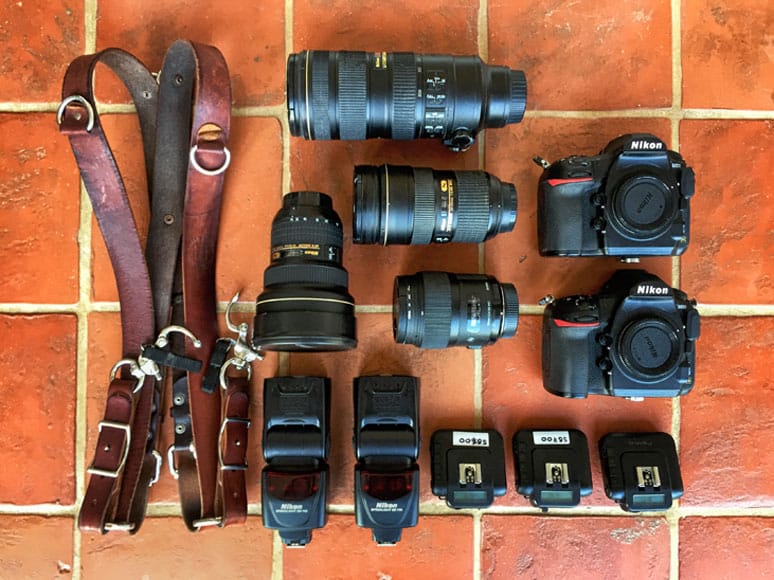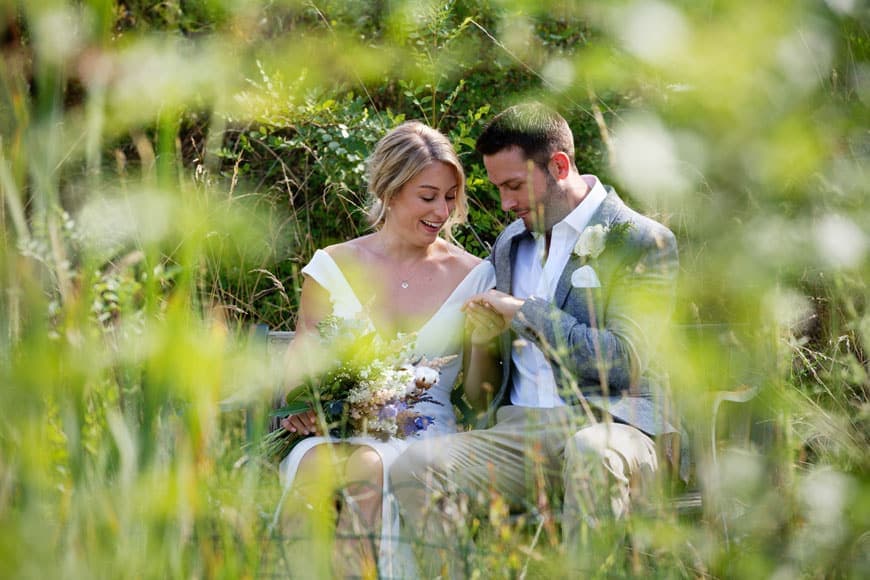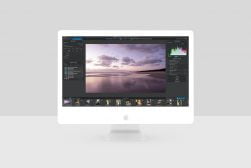






David Page
Wedding | Last Updated: March 19, 2021
Hi, my name is David Page and for the past 13 years I’ve been photographing weddings here in the South West of France.
I started with photography as a hobby around 2003. Shooting Black & White film, developing, and printing it, all myself, in our toilet, which was converted into a temporary darkroom.
Happy memories of the pungent chemical smells, the magic of the image appearing on paper, and the family shouting outside the toilet telling me to hurry up as nature was calling.
I suppose, like most photographers when they first start, I had no clear style or favoured subject. I just took photos of stuff that appealed to me.
As I was shooting only Black & White, at that time, I had a tendency to look for subjects with form, composition, contrast, and simplicity which didn’t need colour to convey emotions to the viewer.
For the occasional photograph which turned out OK, I would print it big, frame it, and hang it in the house. It wasn’t long before I was selling these framed prints at local craft fairs, markets, and, eventually, local galleries. People seemed to like them, as they bought them to display in their own homes.
Around 2005, people started to appear in my photography, and I got more interested in portraits, expressions, and characters. I started shooting family portraits with no real idea what I was doing, I just knew I didn’t want formal faces just staring at the camera.
My approach was to set up a couple of Bowen studio lights (guide), sit the subjects down on something comfortable, and then we’d just start talking.
I would have the most bizarre conversations with my subjects, trying to get them to engage more with each other than me and then, just when they were really getting animated with whatever ridiculous subject we were talking about, click, click, click.
The portraiture sessions took off very quickly and I was soon very busy with this, especially as I still had a proper job to do Monday to Friday.
After the portraits, I got asked by some old portrait clients to shoot their weddings for them.
Weddings were not something that I particular wanted to do. I probably still harboured ambitions to end up selling fine art photographs in some trendy little boutique shop near a beach somewhere, but, heh, decided to give wedding photography a go anyway.
I approached weddings with the same naivety as I had approached portraiture.
Having no idea what I was doing, I just photographed stuff that I thought was interesting. Turns out that I had accidentally found my style and genre of photography all in one accidental go and it had a name, or to be honest several names. Reportage, photo documentary, candid photography.
I finished my day job in 2006 and decided to do the photography thing full time.
After a year, I figured things were going pretty well so, just to mix it up a bit, we moved from the UK across, to go and live in France.
I have now covered over 300 weddings here in France, sharing the day with couples from both France and from all over the world: Australia, America, Canada, Brazil, China, Sweden, UK, Ireland, Lebanon, to name but a few.
I still shoot photographs to hang on peoples walls and continue to exhibit these, albeit infrequently, in Galleries in France.
I love doing what I do and sharing this most special of days with some amazing people from all over the world, but, best of all, I love getting the feedback from them when they receive their wedding day reportage, photo documentary images. Love my life.
GEAR TALK
Before I start on gear talk, and what’s “in my bag,” it should be said that I’m not hugely absorbed by the vast array of camera kit and gadgets out there.
For me, the camera/lens setup is all about image quality and reliability. Each time I have upgraded my kit, I have done so for very specific reasons. All I ask of my camera kit is to produce images of the best quality I can afford and for it to do it every single time I press the shutter button.
I started shooting with a Ricoh KR5 and a 50mm lens (no idea what make). I then upgraded to a Nikon F65, and it was with this camera that I started selling photographs and shooting portraits.
The Nikon F65 was great and, as a manual film camera, it gave me a great foundation for understanding the technical basics of photography and light.
I entered the digital age with a Nikon D100 which I think I still have somewhere in a box hidden away with my many other boxes of cameras. I remember being so utterly disappointed with the D100 . Even though it was digital, my eye and habits were still firmly attached to Black & White.
I bought an Epson stylus 2100 as all the publicity said this printer was the best BW printer around, you simply couldn’t tell the difference between silver or digital prints. But when that first Black & White print popped out, my sigh of disappointment was heartfelt.
It didn’t matter what adjustments I made, what papers I used, what profiles I used, the prints were clearly not true, neutral Black & White. It had a slight colour cast varying from magenta to green. I remember being so angry at all the reviews I had read where each and every one of them had said it gave true, neutral Black & White prints.
Eventually the issue was resolved with the purchase of a VERY expensive RIP software package from Imageprint, which, it has to be said, just worked first time, right out of the box, and gave the most sublime Black & White (and colour) prints.
Anyway back to the camera kit… I upgraded when I needed better quality images, I upgraded when I needed more flexibility from the camera, I upgraded when I had exceeded shutter counts. My camera bodies have included the Nikon D100, D200, D300, D700 (this was a beauty!), D4 (awesome camera, low light magician).
I have remained with Nikon since that first Nikon F65 but only really because of all the money I have invested into those lenses and the fact that I’m used to Nikon and I’m lazy. I was considering a switch after I upgraded from my D4 setup, with a move over to Sony, but I just couldn’t convince myself that after all the hassle of changing, it would help my photography.
I currently use a pair of Nikon D850’s. Before this, I was using my D4 alongside my D700. However, using two different cameras (slightly different configurations for buttons, custom settings, didn’t play well with my muscle memory), still produced two slightly different looking images.
With my quest for image quality always highest on my list, I decided to go for a pair of cameras to keep everything I produced absolutely consistent. The D850 was simply the only camera that Nikon had at that time that was suitable for me to move to.
What do I love about my D850’s? Well, mainly, that they’re mine and that I do love the image quality and the fact that they have never missed a beat/shot for me.
Lenses? Well, here we go for the real business end of the camera. For the wedding day, I arrive sporting my trusty and uber comfortable HoldFast MoneyMaker strap.
Hanging off my right hand side will be one D850 with my Nikon 24-70mm f/2.8 firmly attached. This lens is just perfect. I’ve got 2.8 all the way through from 24-70mm, sharp and fast, all the way. I’ll probably shoot around 70% of the days photos with this lens.
On my left hand side will be the other D850 with the Nikon 70-200mm f/2.8 attached. I think sometimes I take this lens for granted but it really is so good with the most beautiful bokeh rendering when picking out portraits of people at a distance.
With these two lenses attached, I’ve got most things covered from discreetly afar during bridal preparations, keeping out of the way of the action during the ceremony, getting up close in the thick of the drinks, receptions, bridal portraits, and speeches.
I do have the Nikon 14-24mm f/2.8 to makeup that classic holy trinity, but, in truth, for weddings, it is only rarely used. I do get it out, every now and again, if I see a creative opportunity or if the bridal preparations are taking place where space is rather confined.
As the light drops during the day, I normally keep the Nikon 24-70mm f/2.8 on but may need to up the iso to 6400 and the D850 copes with this admirably but still slightly short of what the D4 used to deliver.
The Nikon 70-200mm f/2.8 will be stowed safely away in my Billingham wedding bag to be replaced with my Sigma 35mm f/1.4.
I’d shoot this quite happily, all day, wide open at f/1.4, safe in the knowledge that, yes, I’m going to get a few shots where I’ve not quite nailed the focus, but, more often than not, it will deliver. This is one of those lenses that does deliver a nice “feel” to the image, difficult if not impossible to actually quantify but they just exude a warmth, an intimacy, that I do love.
When it’s time for the dancing to begin, this is where the time to start putting lighting plans, A, B and C into place. If there’s one thing I’ve learnt it’s that when it’s time for the 1st dance, never take any lighting for granted!
I always speak with the band or DJ beforehand and ask for white light if possible for the 1st dance, definitely no smoke (you try focusing through that), and definitely no nuclear, red type, lighting, personal thing but I just hate it. The most unflattering lighting look in my opinion.
I’ll have a look at the DJ/Band lighting and get some ideas for shots using just that and my 35mm f/1.4. I’ll then setup a couple of Nikon SB700 Speedlights, usually on tripods (very carefully bungee strapped to an immoveable object as the room is about to fill up with people who are about to party), using remote cactus controllers from my 24-70mm.
The Cactus controllers are really easy to use, with individual power adjustments for each of the speedlights available, directly from the cactus on my camera. With this setup, I’m pretty much covered to use my own controlled lighting or/and go with the venue lighting.
I shot a wedding last year that, for one reason and another, (weddings are not a fixed thing) ended up with an impromptu 1st dance held, not in the expected location i.e. where I had setup the lights and where the DJ was, but right in the middle of a lawn in front of the venue, no lights, practically pitch black.
Using a bit of lateral thinking, I just asked a few of the guests to get their phones out, hold them up high, and light the dancing couple up, other guests quickly copied the idea and I got a set of photos that I and the couple were really pleased with. Smartphone lighting, it’s a thing.
I’m just about to increase my lens collection with the addition of a Nikon 85mm f/1.4 to give me some more options when the wedding is running late and the light is dropping a little to quickly for comfort.
When I lug all this kit into the wedding, I use two bags. The main bag is a Billingham 445, which holds all my bodies, lenses, cards, cleaners, and business cards! The second bag is an older, smaller, pretty battered, Billingham to carry my speedlights and cactus controllers around in, for the evening. I’ve had those bags for years and years, that’s why I bought them. They just last.
I always keep a tripod in the boot of my car, in case I need any atmospheric, moonlit, Chateau-type shots before I leave the wedding. I use a 3 Legged Thing Punks tripod, it’s great, lightweight, solid, and compact. It’s rarely used at weddings, but I do use it more when I’m out walking and taking long exposures with my Big Stopper ND filter on.
Editing photos is all done on my iMac configured with a second Dell monitor. I have been using DxO PhotoLab for the majority of my processing, but, this wedding season, I had a software issue and it wouldn’t load so whilst the lovely tech support guys at DxO were sorting it out, I had to go back to using Nikons own Capture NX-D software.
Now, the Capture NX-D software is quite, shall we say, different in it’s layout and usage to most other editing software, unique would be a nice way of saying it, clunky would be another. However, the image quality in editing RAW files is simply the best.
DxO PhotoLab is close but still comes second, in my opinion. However, DxO does offer a lot of functionality that is simply not in Capture NX-D and also provides the excellent NIK tools for some more creative editing.
Suffice to say that DxO PhotoLab is now back working and I have just upgraded to Photolab3 but I am still using Capture NXD for most of my editing work.
Thanks for taking the time to read this and if anyone out there is thinking of a destination wedding in France be sure to get in touch. It’d be great to hear from you.
www.davidpagephotography.com | @davidpagephotographer

Check out these 8 essential tools to help you succeed as a professional photographer.
Includes limited-time discounts.












